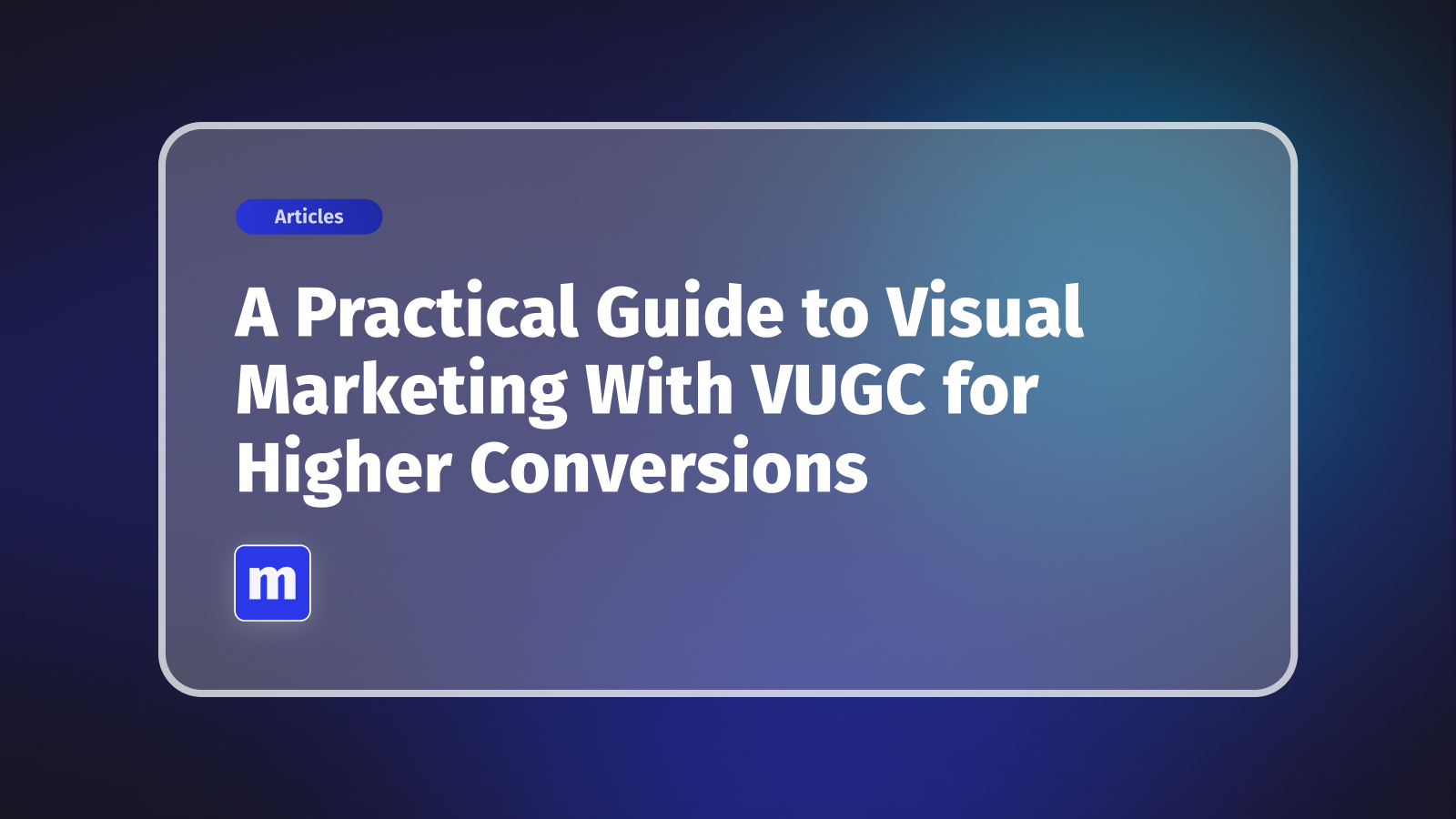
- Why Customer Journey Optimization Is Your New Competitive Edge
- Mapping The Five Stages Of The Modern Customer Journey
- How AI Is Redefining the Customer Experience
- Building a Customer Journey Map That Actually Works
- Measuring What Matters in Your Optimization Strategy
- Actionable Strategies for Continuous Journey Improvement
- Common Questions About the Customer Journey
So, what exactly is customer journey optimization?
Think of it as looking at your business through your customer's eyes. It’s the process of carefully analyzing every single interaction they have with your brand—from the first ad they see to the support email they receive a year later—and making it better. The goal is to create a seamless and personalized experience that feels natural and helpful.
Instead of just focusing on single, isolated moments like a sale, you're looking at the entire path. Your job is to find the bumps, roadblocks, and confusing detours in that path and smooth them out. It's all about reducing friction and increasing customer delight at every step.
Why Customer Journey Optimization Is Your New Competitive Edge
Let's be real—customers today have high expectations. A good product or a decent price isn't enough anymore. They crave an experience that's intuitive and effortless, from the moment they discover you to long after they've become a customer. This is exactly why customer journey optimization has shifted from a "nice-to-have" marketing tactic to a core part of any smart business strategy.
Imagine you're an expert guide leading a group on a challenging hike. You aren't there to carry the hikers (your customers), but you are there to clear fallen logs from the path, point out tricky terrain ahead, and make sure the journey is so enjoyable they can't wait to tell everyone about it. That's the essence of what we're doing here.
Shifting from Company-Focused to Customer-Obsessed
This really comes down to a fundamental shift in thinking. You move away from a company-focused mindset ("How can we sell more stuff?") to a customer-obsessed one ("How can we make our customer's life easier?"). When you actively work to smooth out their experience, it has a direct and powerful impact on your business.
The data backs this up. Companies that get this right see major improvements across the board:
- Higher Conversion Rates: A clear, easy path from discovery to purchase means fewer people giving up halfway through. More visitors become customers.
- Increased Customer Satisfaction: When things just work, people are happier. It’s no surprise that companies focusing on the journey see Net Promoter Scores (NPS) jump by as much as 20%.
- Stronger Brand Loyalty: A great experience builds trust. That trust creates an emotional connection, turning a one-time buyer into a lifelong fan.
- Boosted Revenue: Happy, loyal customers don't just stick around; they spend more over their lifetime. This creates a much more stable and predictable financial future for your company.
By putting yourself in your customer’s shoes, you begin to see the small points of friction that, when combined, create major barriers to purchase and loyalty. Fixing these issues is the secret to unlocking growth.
In the end, optimizing the customer journey isn't just about feel-good metrics. It's about building a more resilient, profitable business. When you deeply understand what your customers need at each stage, you transform a simple transaction into a memorable relationship. This focus on the complete experience is what separates the brands that thrive from the ones that get left behind. It's your new, undeniable competitive edge.
Mapping The Five Stages Of The Modern Customer Journey
To truly get a handle on customer journey optimization, you need a map. Not just any map, but a detailed guide that shows you exactly how people interact with your brand from start to finish. We're not guessing here; we're breaking down the journey into five distinct stages.
Each stage represents a different mindset for your customer and a unique opportunity for you to connect. By seeing the journey this way, you can stop using a one-size-fits-all approach and start delivering the right message at the right time. It’s all about guiding people smoothly from one phase to the next.
This image shows how a team might visualize these connected stages, focusing on identifying every crucial touchpoint along the way.
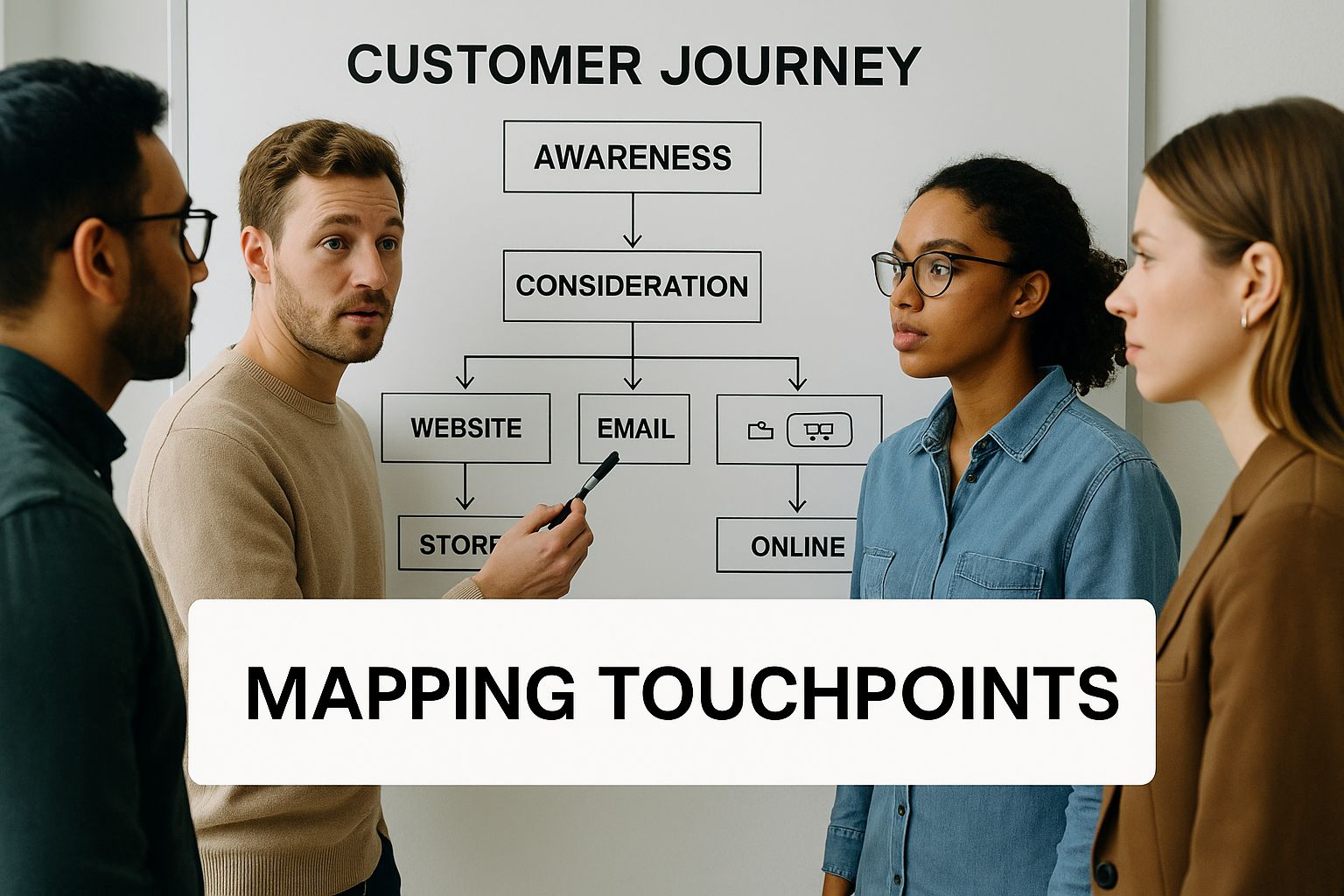
The big takeaway? A great journey map isn't a solo project. It's a team effort that pulls together different viewpoints to create a full, rich picture of the customer experience.
Awareness: The First "Hello"
This is where it all begins. A potential customer has just learned your brand exists. They aren't actively shopping; they’ve simply stumbled upon you through a targeted social media ad, a helpful blog post, or a word-of-mouth recommendation.
At this point, their mindset is pretty passive. They have a need, but they might not have even put a name to it yet. Your goal isn't to make a hard sell. It’s to get on their radar and leave a positive, memorable impression. Be helpful, not pushy.
The primary goal of the Awareness stage is education and discovery. You're planting a seed by offering value upfront and positioning your brand as a go-to resource, long before a purchase is even on the table.
Consideration: The Deep Dive
Okay, now things are getting a little more serious. The person is aware of their problem and knows you offer a potential solution. They're now actively researching, comparing your brand to your competitors, reading reviews, and digging into the nitty-gritty of your products.
Their mindset has shifted from passive discovery to active evaluation. They're asking tough questions: "Does this actually solve my problem?" or "Can I trust this company?" Your job is to build that trust and clearly show why you're their best bet. This is where detailed product info, genuine customer testimonials, and clear comparisons make all the difference.
Conversion: The Moment of Truth
This is it—the critical moment when a prospect decides to become a customer. They're clicking "Add to Cart," signing up for your service, or requesting that quote. Everything you've done so far has led to this point.
The customer's mindset is now laser-focused and ready for action. They want to commit, but the smallest bit of friction can send them running. A confusing checkout, unexpected shipping costs, or a slow-loading page are conversion killers. Your goal is simple: make the transaction as smooth and painless as possible. Every click should feel intuitive and reassuring.
Retention: Keeping the Relationship Alive
The journey isn't over just because you made a sale. Far from it. The Retention stage is where you turn a one-time buyer into a loyal, repeat customer. This phase is all about the post-purchase experience, from product onboarding and customer support to ongoing communication that adds value.
Here, your customer is looking for validation. They want to feel good about their decision and know they made the right choice. Your mission is to exceed their expectations, offer standout support, and give them compelling reasons to come back. After all, it's far cheaper to keep a customer than to find a new one.
Advocacy: Creating Your Ultimate Fans
This is the final, and arguably most valuable, stage of the journey. Advocacy is where happy customers transform into your biggest cheerleaders. They leave glowing reviews, recommend you to friends and family, and share their positive experiences all over social media.
An advocate’s mindset is built on loyalty and genuine enthusiasm—they feel a real connection to your brand. Your goal is to empower these fans and make it incredibly easy for them to spread the word. Think referral programs, user-generated content campaigns, or just continuing to deliver an experience that's worth talking about.
To help you visualize how all these pieces fit together, here's a practical blueprint for customer journey optimization.
A Practical Blueprint of the Customer Journey Stages
This table breaks down each stage, offering a clear look at what your customer is thinking, what your goals should be, and where you can make the biggest impact.
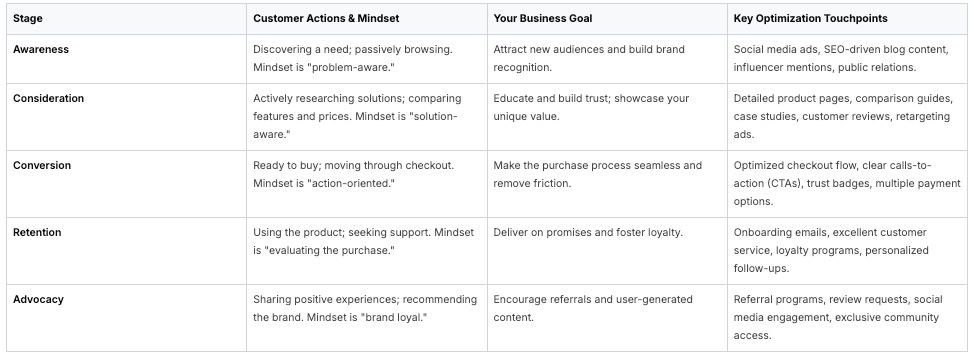
Creating this map is a crucial first step. When you're ready to dig deeper, be sure to check out our guide covering 7 tips and tools for mapping out the e-commerce shopping journey for more advanced strategies.
Here is the rewritten section, designed to sound completely human-written and natural.
How AI Is Redefining the Customer Experience
If you think of a customer journey map as a static, printed road map, then Artificial Intelligence is the live GPS. It's the technology that turns a fixed plan into a dynamic, real-time conversation between you and your customer. It’s no longer about abstract charts on a whiteboard; it’s about delivering hyper-personalization at a scale that was once pure science fiction.
A traditional journey map is helpful, for sure, but it can’t account for a sudden traffic jam or a closed road. AI, on the other hand, is constantly analyzing the situation. It predicts the best route, sees friction ahead, and reroutes the customer instantly to ensure they get where they’re going smoothly. This is the new reality of customer journey optimization.
The Power of Predictive Personalization
The real magic of AI is its knack for predicting what a customer wants, sometimes even before they do. By crunching massive amounts of data—browsing history, past purchases, time of day, even the weather—AI can create experiences that just feel right.
This isn't some far-off concept; it’s already happening all around us. Think about Netflix’s recommendation engine. It’s so good at figuring out your next binge-watch that it famously drives over $1 billion in annual customer retention. Or consider Starbucks, which uses predictive AI to send you an offer for a Frappuccino just as the afternoon heat is peaking, all while making sure your local store has everything in stock.
This isn't a niche trend; it's a fundamental shift. By 2025, an estimated 95% of all customer interactions will be touched by AI in some way. This incredible adoption rate is fueled by the fact that 90% of companies are already using AI to get a leg up on their customer experience. You can dig into more data on these customer experience trends in recent industry reports.
The screenshot below drives home just how central AI is becoming to the customer service world.
What’s fascinating here is the rapid adoption of tools like chatbots. We're on track for 80% of customer service teams to use them for front-line questions, which is smart. It handles the simple stuff, but keeps a clear path for customers to reach a human when things get complicated.
From Static Websites to Dynamic Conversations
One of the biggest wins with AI is its ability to transform a one-size-fits-all website into a personal welcome mat. Instead of showing every visitor the same generic page, an AI-driven site can adapt on the fly based on who's visiting.
A first-time visitor might see an introductory offer and helpful "getting started" guides. A loyal, returning customer? They'll see new arrivals in their favorite category or accessories for their last purchase. This kind of dynamic content makes each person feel seen and understood, which is a powerful way to cut bounce rates and keep people engaged.
Key Takeaway: AI lets you shift from broadcasting one message to many people to having a one-to-one conversation—at scale. It’s about making sure every touchpoint is relevant, timely, and actually useful to the customer.
AI-Powered Support That Never Sleeps
Another game-changer for customer journey optimization is the rise of intelligent chatbots and virtual assistants. These tools offer instant, 24/7 support, knocking out common questions and resolving simple issues without making a customer wait in a queue.
This creates a win-win situation:
- For the Customer: They get their problems solved immediately. Less frustration, more satisfaction.
- For the Business: It frees up your human support agents to tackle the complex, high-value problems that truly need a human touch.
Ultimately, AI isn't about replacing people. It's about augmenting them. By taking over the repetitive tasks and delivering deep analytical insights, AI gives your team the power to be more strategic, empathetic, and effective. It's the engine that helps brands not just meet, but exceed the sky-high expectations of today's consumer.
Building a Customer Journey Map That Actually Works
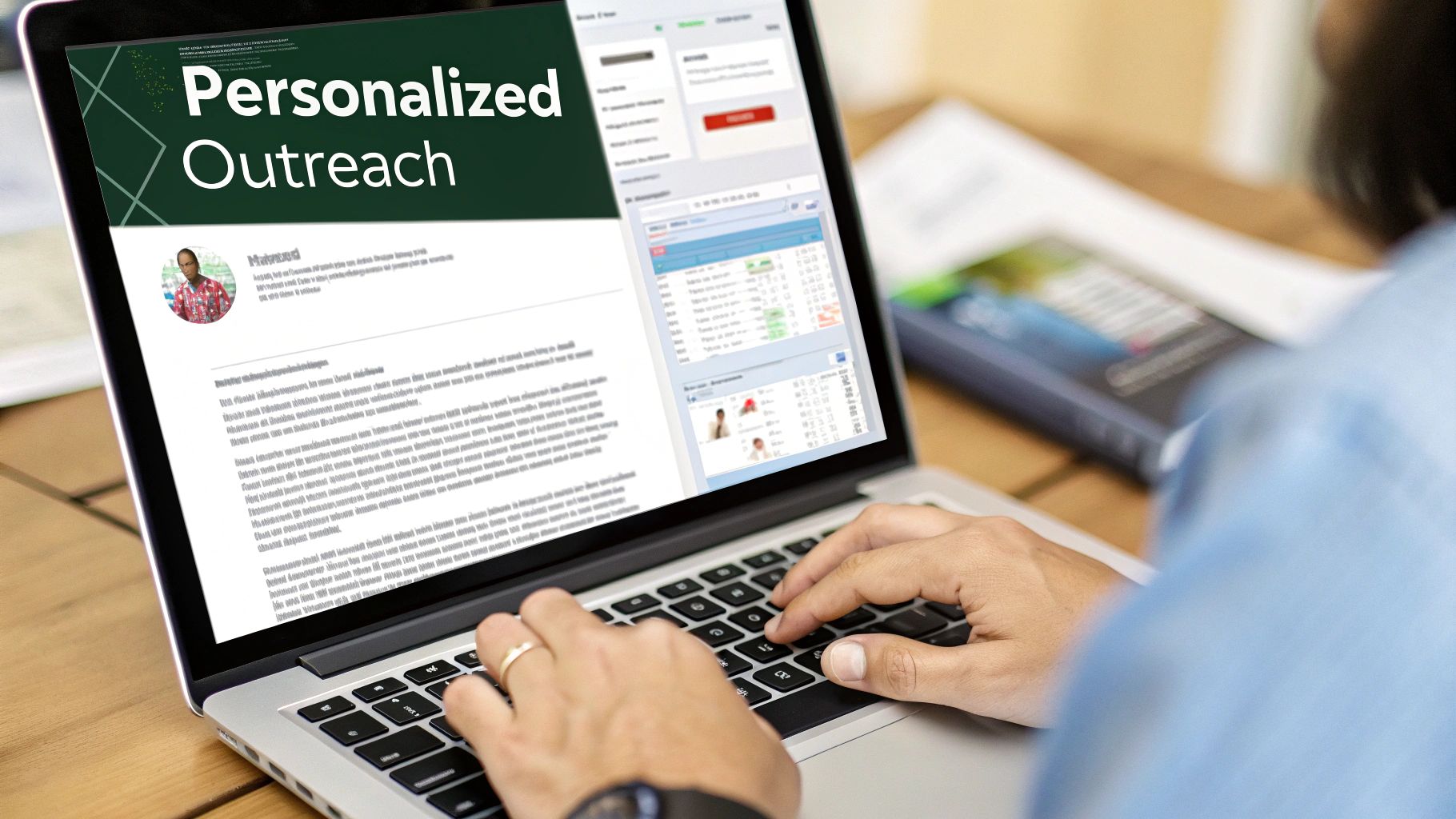
A great customer journey map isn't just a pretty chart you hang on the wall. It's a living, breathing tool that gets your entire team aimed at the same target: creating a genuinely better customer experience. To build one that actually drives change, you have to move past assumptions and get your hands dirty with real data.
The whole point is to stop guessing what your customers do and start knowing. This means pulling together information from all over the place to build a complete, empathetic picture of their world. When you get it right, your map becomes the lens for all your customer journey optimization work, showing you exactly where your efforts will make the biggest impact.
Gather Your Raw Materials
Before you can draw the map, you need to survey the territory. This means collecting both hard numbers (quantitative) and human stories (qualitative) to understand the "what" and the "why" behind what your customers are doing. Think of yourself as a detective piecing together clues.
Essential Data Sources to Tap Into:
- Customer Interviews and Surveys: Honestly, there’s no substitute for just talking to your customers. Ask them about their frustrations, their "aha!" moments, and what almost made them walk away. Surveys can then help you see those patterns at a larger scale.
- Website and App Analytics: Tools like Google Analytics show you the literal path people take. Where do they come from? Where do they get stuck and leave? This data uncovers the practical friction points, like a checkout form that’s just too confusing.
- Customer Support Tickets: Your support team is on the front lines, hearing about problems every single day. Their ticket logs are a goldmine for understanding post-purchase headaches and product confusion.
By blending these sources, a real story starts to emerge. Your analytics might show you that a bunch of people are abandoning their cart on the shipping page, but a customer survey will tell you why—the unexpected shipping costs are giving them sticker shock.
Synthesize Data into a Visual Story
With all your research gathered, the next step is to translate it into a visual story that your whole team can actually use. This is where the real mapping begins. A good map should visualize the journey across those key stages we talked about: Awareness, Consideration, Conversion, Retention, and Advocacy.
For each stage, you need to document a few key things, all from the customer's point of view:
- Actions: What is the customer doing right now? (e.g., Googling solutions, comparing prices, contacting support).
- Thoughts & Feelings: What’s going on in their head? Are they curious, anxious, frustrated, or excited?
- Pain Points: What specific roadblocks or frustrating moments are they hitting?
- Opportunities: Based on their pain points, where can you jump in and make things better?
A journey map's real power is its ability to build empathy. When your engineering team sees the genuine frustration a customer feels when a page takes too long to load, they're far more motivated to fix it than if they just saw another ticket in a backlog.
This process turns cold data into a human story, highlighting the exact moments of friction you need to fix and the moments of delight you should be creating more of.
Make Your Map an Actionable Tool
A journey map is completely useless if it just sits in a folder collecting digital dust. To make it a core part of your customer journey optimization strategy, it has to be a living document that informs daily decisions. For Shopify merchants, this might mean discovering that customers get confused about sizing during the consideration phase. The opportunity? Add shoppable videos showing the clothes on different body types. If you need a practical walkthrough, check out our guide on how to create a customer journey map that converts.
This focus on mapping isn't just a trend; it's becoming a standard business practice. The global customer journey mapping market is projected to explode to $15.8 billion by 2025, a huge jump from $5.6 billion in 2020. Much of this growth comes from new AI tools that help businesses anticipate customer needs and personalize interactions, which can boost customer satisfaction by up to 25%.
By treating your map as an ongoing project, not a one-and-done task, you can make targeted improvements that pay off in both happier customers and a healthier bottom line.
Measuring What Matters in Your Optimization Strategy
So, you're putting in the work to optimize the customer journey. That's a huge step. But how do you actually know if it's working? The old saying holds true: if you can't measure it, you can't improve it. To really see the impact of your efforts, you have to look past the vanity metrics and dial in on the numbers that signal a healthy, lasting customer relationship.
Think of it like a doctor checking a patient's vital signs. A single number, like temperature, doesn't tell the whole story. But when you combine it with blood pressure and heart rate, you get a much clearer picture of overall health. In customer journey optimization, your vital signs are the metrics that reflect genuine satisfaction, loyalty, and long-term value.
The Core Metrics That Define Success
While every business has its own unique dashboard, a few core metrics are almost universally critical for measuring the health of your customer journey. They don't just tell you what happened; they give you powerful clues as to why.
Here are the big three you should always keep an eye on:
- Net Promoter Score (NPS): This classic metric is built on a single, powerful question: "On a scale of 0-10, how likely are you to recommend our brand to a friend?" It's a direct pulse check on customer satisfaction and loyalty, splitting your customers into Promoters, Passives, or Detractors. A rising NPS is one of the strongest signs that your journey improvements are creating happier, more loyal advocates for your brand.
- Customer Churn Rate: This is the percentage of customers who walk away over a specific period. A high churn rate is a massive red flag, often pointing to friction, a poor onboarding experience, or a frustrating post-purchase journey. Slashing your churn rate is one of the most direct financial wins you can get from a well-optimized customer experience.
- Customer Lifetime Value (CLV): This metric forecasts the total revenue you can reasonably expect from a single customer over their entire relationship with you. When you focus on creating a fantastic journey, you naturally encourage repeat business and deepen loyalty, which sends your CLV climbing. It’s a shift in mindset from chasing one-off sales to building profitable, long-term relationships.
Monitoring these KPIs is all about connecting your hard work to real business outcomes. When you see your churn rate drop right after simplifying your onboarding process, you have concrete proof that your strategy is paying off.
Using Data to Make Agile Decisions
The ability to track these KPIs is getting better and more powerful every day. The customer journey analytics market is projected to explode to $12.2 billion by 2025—a huge jump from $4.7 billion in 2020. What's driving this? AI-powered and real-time tools that let companies analyze customer paths with incredible detail, helping them meet the sky-high expectations of today's shoppers.
Modern analytics platforms give you a live, over-the-shoulder look at what’s happening, allowing you to be incredibly nimble. You can pinpoint exactly where customers are dropping off in your checkout funnel and then use that insight to make immediate, targeted fixes. For anyone on Shopify, spotting these friction points is crucial, and you can increase your eCommerce conversion rate with proven strategies once you know where to look.
Ultimately, measuring what matters empowers you to stop guessing and start making data-driven decisions. It turns customer journey optimization from a theoretical goal into a practical, results-oriented discipline with a clear, demonstrable impact on your bottom line.
Actionable Strategies for Continuous Journey Improvement
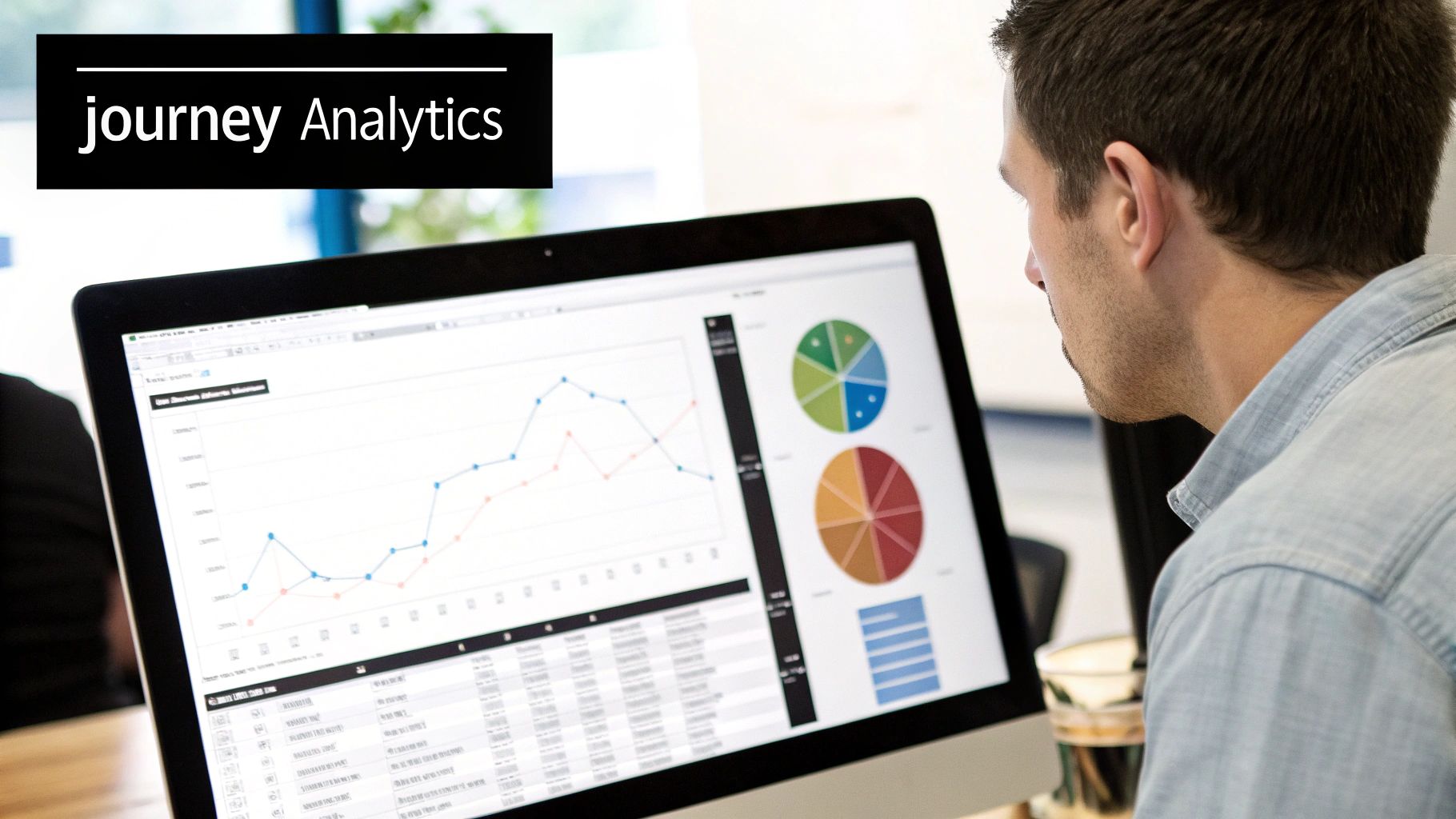
Let's be clear: effective customer journey optimization is a marathon, not a sprint. The best maps and sharpest metrics are just a starting point. Real success comes from building a culture of continuous improvement—making agility and customer-centric thinking part of your company’s DNA.
This isn’t about one-off projects. It's about adopting an iterative "test and learn" mindset to consistently refine every touchpoint. From the very first ad a customer sees to a support ticket they submit a year later, the goal is a perpetual cycle of listening, testing, and adapting.
Build Cross-Functional Teams
One of the biggest roadblocks to a great customer experience is internal silos. When your marketing, sales, and support teams operate in their own little worlds, the customer's path becomes choppy and frustrating. The fix? Build cross-functional teams dedicated to owning the entire customer experience.
When you bring people from different departments to the same table, you get a complete picture of the journey. The marketing team finally understands the support team's biggest headaches, and the product team gets unfiltered feedback from sales on what customers actually want. This shared ownership is the secret sauce for genuine customer journey optimization.
The most powerful improvements happen when a business stops seeing the customer journey in fragments and starts viewing it as a single, shared responsibility. This collaborative approach unlocks insights that no single department could find on its own.
Foster a Test and Learn Mindset
To truly improve, you have to embrace experimentation. A "test and learn" culture means you're constantly running small experiments to see what moves the needle. This is where A/B testing becomes your best friend.
You can test just about anything to find those small wins that add up over time.
- Email Subject Lines: Which one gets more opens?
- Website CTAs: Does "Buy Now" really work better than "Add to Cart"?
- Landing Page Layouts: Does a video convert more people than a static image?
- Checkout Processes: Can we reduce cart abandonment just by removing one field?
This relentless testing eliminates guesswork. Instead of relying on assumptions, you're making decisions based on what your customers actually do. To really dig into this, it's worth understanding how to leverage customer interactions to boost sales.
Proactively Gather and Act on Feedback
You can’t fix a journey without listening to the people on it. Gathering customer feedback is non-negotiable, but it needs to feel helpful, not intrusive. Weave feedback loops naturally into the customer experience.
For example, use simple, one-question surveys at key moments, like right after a purchase or a support chat. Keep an eye on social media mentions and online reviews to catch what people are saying unprompted. A fantastic way to enhance the experience is by leveraging personalisation for an exceptional website and adapting based on their direct input.
But the most important part is to act on the feedback. When customers see their suggestions lead to real changes, it builds incredible trust and loyalty. This closes the loop, turning a simple data point into a powerful tool for building stronger, more profitable relationships.
Common Questions About the Customer Journey
As you start digging into customer journey optimization, you'll inevitably run into a few common questions. It’s totally normal. Getting these concepts straight is the key to building a strategy that actually works and doesn't just stay on a whiteboard.
Let's clear up some of the most frequent sticking points.
What’s the Difference Between Customer Journey and UX?
This is a big one, and it’s easy to see why they get confused. They're related, but they operate on different scales.
Think of User Experience (UX) as a single, focused interaction. It’s all about how a person feels while using one specific thing you've built, like your website or app. Is the checkout process smooth? Can people find what they need without getting frustrated? That’s great UX.
The Customer Journey, on the other hand, is the entire story. It’s the full, end-to-end relationship someone has with your brand, weaving together all those individual UX moments. It starts way before they ever land on your site—maybe with a TikTok video—and extends long after, like when they contact customer support six months later.
In short, UX is a chapter. The customer journey is the whole book. You need well-written chapters (great UX) to create a compelling novel (a fantastic customer journey).
What Are the First Steps for a Small Business?
If you're running a small business, the idea of mapping a "complex journey" can sound daunting. Don't worry, you don’t need a massive budget or a dedicated analytics team to get started. The most powerful first step is also the simplest: talk to your customers.
Seriously. Find five people who bought from you recently and just ask them about their experience. What problem were they trying to solve? How did they find you? What almost made them not buy? You'll be amazed at what you learn from a few honest conversations.
From there, you'll likely spot one or two recurring themes or friction points. Maybe everyone mentions that they couldn't figure out your return policy. Boom. That's your first project. Fixing one major snag can make a huge difference.
How Do I Manage a Complex Multi-Channel Journey?
Customers today bounce between social media, email, your website, and maybe even a physical store. Keeping that experience consistent can feel like trying to nail Jell-O to a wall, but the secret is to focus on cohesion.
Start by listing your main channels. Then, for each one, ask: "Does this feel like us?" The offer in a promotional email should match the landing page it clicks through to, right down to the visuals. When a customer uses your support chat, the agent should be able to see their recent orders without asking.
The goal isn't immediate perfection across every channel. It's about breaking down the walls between them. When your teams and tools share information, the journey feels connected and intelligent, not disjointed. That’s how you build a seamless experience, no matter where your customer shows up.
Ready to turn views into sales? Moast allows Shopify merchants to add free, shoppable videos from Reels and TikTok directly to their stores in just 5 minutes. Showcase your best content, build trust, and drive conversions—all with unlimited views and no hidden costs. Get started for free today.
Related content
Turn your social content into a revenue channel
Turn your TikToks and Reels into shoppable videos and boost conversions by 3.5x.

